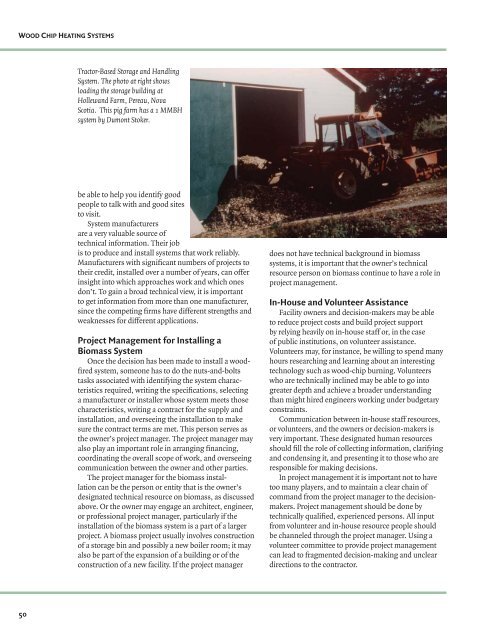Wood-Chip Heating Systems - Biomass Energy Resource Center
Wood-Chip Heating Systems - Biomass Energy Resource Center
Wood-Chip Heating Systems - Biomass Energy Resource Center
Create successful ePaper yourself
Turn your PDF publications into a flip-book with our unique Google optimized e-Paper software.
WOOD CHIP HEATING SYSTEMS<br />
50<br />
Tractor-Based Storage and Handling<br />
System. The photo at right shows<br />
loading the storage building at<br />
Hollewand Farm, Pereau, Nova<br />
Scotia. This pig farm has a 1 MMBH<br />
system by Dumont Stoker.<br />
be able to help you identify good<br />
people to talk with and good sites<br />
to visit.<br />
System manufacturers<br />
are a very valuable source of<br />
technical information. Their job<br />
is to produce and install systems that work reliably.<br />
Manufacturers with signifi cant numbers of projects to<br />
their credit, installed over a number of years, can offer<br />
insight into which approaches work and which ones<br />
don’t. To gain a broad technical view, it is important<br />
to get information from more than one manufacturer,<br />
since the competing fi rms have different strengths and<br />
weaknesses for different applications.<br />
Project Management for Installing a<br />
<strong>Biomass</strong> System<br />
Once the decision has been made to install a woodfi<br />
red system, someone has to do the nuts-and-bolts<br />
tasks associated with identifying the system characteristics<br />
required, writing the specifi cations, selecting<br />
a manufacturer or installer whose system meets those<br />
characteristics, writing a contract for the supply and<br />
installation, and overseeing the installation to make<br />
sure the contract terms are met. This person serves as<br />
the owner’s project manager. The project manager may<br />
also play an important role in arranging fi nancing,<br />
coordinating the overall scope of work, and overseeing<br />
communication between the owner and other parties.<br />
The project manager for the biomass installation<br />
can be the person or entity that is the owner’s<br />
designated technical resource on biomass, as discussed<br />
above. Or the owner may engage an architect, engineer,<br />
or professional project manager, particularly if the<br />
installation of the biomass system is a part of a larger<br />
project. A biomass project usually involves construction<br />
of a storage bin and possibly a new boiler room; it may<br />
also be part of the expansion of a building or of the<br />
construction of a new facility. If the project manager<br />
does not have technical background in biomass<br />
systems, it is important that the owner’s technical<br />
resource person on biomass continue to have a role in<br />
project management.<br />
In-House and Volunteer Assistance<br />
Facility owners and decision-makers may be able<br />
to reduce project costs and build project support<br />
by relying heavily on in-house staff or, in the case<br />
of public institutions, on volunteer assistance.<br />
Volunteers may, for instance, be willing to spend many<br />
hours researching and learning about an interesting<br />
technology such as wood-chip burning. Volunteers<br />
who are technically inclined may be able to go into<br />
greater depth and achieve a broader understanding<br />
than might hired engineers working under budgetary<br />
constraints.<br />
Communication between in-house staff resources,<br />
or volunteers, and the owners or decision-makers is<br />
very important. These designated human resources<br />
should fi ll the role of collecting information, clarifying<br />
and condensing it, and presenting it to those who are<br />
responsible for making decisions.<br />
In project management it is important not to have<br />
too many players, and to maintain a clear chain of<br />
command from the project manager to the decisionmakers.<br />
Project management should be done by<br />
technically qualifi ed, experienced persons. All input<br />
from volunteer and in-house resource people should<br />
be channeled through the project manager. Using a<br />
volunteer committee to provide project management<br />
can lead to fragmented decision-making and unclear<br />
directions to the contractor.





